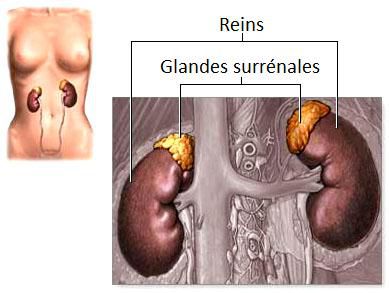-
 Complete metamorphosis
Complete metamorphosis
-
 Fibrous root system
Fibrous root system
-
 Coleoptera
Coleoptera
-
 Aspergillosis
Aspergillosis
-
 Hydroxyl radical
Hydroxyl radical
-
 InVS
InVS
-
 Magnetometer
Magnetometer
-
 Archaea
Archaea
-
 Evergreen
Evergreen
-
 M71
M71
-
 Homo habilis
Homo habilis
-
 Organic Pollution
Organic Pollution
-
 Induration
Induration
-
 Ohm
Ohm
-
 Anus
Anus
-
 Non-spectral colour
Non-spectral colour
-
 Cyclone
Cyclone
-
 Abrasion
Abrasion
-
 Heatwave
Heatwave
-
 Steganography
Steganography
-
 Amniote
Amniote
-
 Arsenic
Arsenic
-
 Playlist
Playlist
-
 Sex glands
Sex glands
-
 TCP/IP
TCP/IP
-
 Vortex
Vortex
-
 Cardia
Cardia
-
 Solar eclipse of 11 August 1999
Solar eclipse of 11 August 1999
-
 Coaxial cable
Coaxial cable
-
 Zoonosis
Zoonosis
Adrenal glands
The adrenal glands belong to the endocrine system.
Function of the adrenal glands
As the name suggests, the adrenal glands are located above the kidneys. Their role is to secrete hormones involved in different processes.
The outer part of the gland, the adrenal cortex, secretes glucocorticoids (cortisone). Among other things, these hormones are responsible for releasing stored glucose and therefore providing energy to the body. The mineralocorticoids (aldosterone) are responsible for potassium and sodium homeostasis. The gland also produces androgens (testosterone), which are also produced by the gonads.
The internal part of the adrenal glands, the adrenal medulla, secretes catecholamines, a group of hormones including adrenaline and noradrenaline. These hormones are involved in the stress response by increasing blood pressure and heart rate.
Structure of the adrenal glands
There are two adrenal glands, which are triangular in shape, and each weighs approximately 5 grams.
They are composed of two different superimposed structures, the central adrenal medulla, which is highly vascularised, and the surrounding adrenal cortex.
 The adrenal glands, located above the kidneys, play an important metabolic role. © DR
The adrenal glands, located above the kidneys, play an important metabolic role. © DR
Latest
Fill out my online form.



